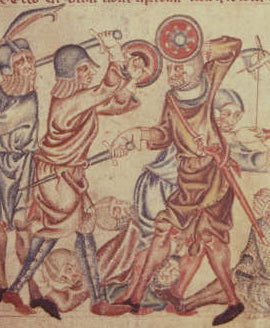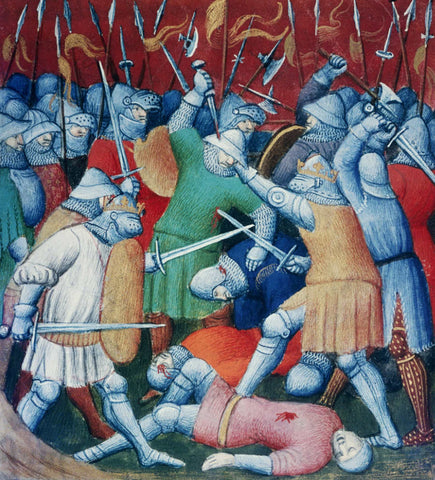Type XV swords arose in Europe at around the same time that mail armor was being supplemented with rigid plates. In the late 12th and 13th centuries the adoption of these more protective armors necessitated a change in sword technology away from the earlier forms designed for hewing cuts and toward a more thrust-oriented form. Type XV swords are typified by a stout, flattened diamond cross section and straight edges that taper to an acute point. The basic type XV is a one handed sword with a short grip, while the variant XVa is a larger sword with a two handed grip that maintains the same blade profile. In today's video Dr. Nathan Clough shows off three type XV swords made by Arms and Armor.

These swords are weapons of war carefully designed to be effective against the best personal defenses of the time. They did not, however, make it possible to stab through plate armor. This is mostly a myth. Type XV swords were designed to overcome armored foes in two primary ways. First, the strong profile taper that distinguishes these blades tends to facilitate a great deal of point control. For example, if you handle the Duke of Urbino sword, pictured above, you will find that it is very easy to move through various guards while maintaining a stable point-forward position.


The substantial pommels on many swords of this type contribute to their stability in the thrust. This was an essential quality for a sword that had to be precisely thrust into the small gaps between armor plates that were otherwise relatively invulnerable to damage from swords. Second, the rigidity of the sword in combination with the acute profile taper were optimized for being driven through the mail and quilted cloth armor that was commonly worn to protect the voids between rigid plate armor sections, for example in the armpit, inside of the elbow, or the groin. The pommels and crosses of swords like these are also very effectively used in half-swording techniques and pommel strikes, as can be seen in the below image from the Codex Wallerstein on the Wiktenaeur site.

Our type XV and XVa swords are close reproductions of existing originals. In all cases we have striven to produce swords that look, feel, and function just like the originals would have back when they were in use.
The German Branch Sword is a replica of a famous mid-15th century sword in the collections of the British Royal Armouries in Leeds. The weight, balance, and dimensions are all accurate to the original sword. Though most often noted for its beautiful writhen hilt, this sword is truly exceptional in the hand, when moving through guards, and when cutting.


The Black Prince Sword is an archetypal example of type XVa. Based on a sword that Ewart Oakeshott believed to be the war sword of Edward of Woodstock, Prince of Wales, this sword epitomizes the ideal sword of the mid-14th century. Please read more about this sword in a previous blog here.


Based on an Italian original that dates from 1380-1410, the Duke of Urbino Sword is a stunning example of form following function. It is also superbly balanced, efficient in the thrust and a capable cutter despite its acute taper. The blade is stiff, elegant, and precisely mirrors its purpose, to find the gap in an opponents armor and open a way to their vitals.


Type XV swords are some of our very favorite pieces here at Arms and Armor. Pick one up and imagine heading into battle, clad in armor, meeting your foes in knightly combat... If you'd like to learn more about these swords please check out this excellent article by Nathan Robinson on MyArmoury.com that includes pictures of many type XV original swords.
Check out the video below:

Nathan Clough, Ph.D. is Vice President of Arms and Armor and a member of the governing board of The Oakeshott Institute. He is a historical martial artist and a former university professor of cultural geography. He has given presentations on historical arms at events including Longpoint and Combatcon, and presented scholarly papers at, among others, The International Congress on Medieval Studies.
Craig Johnson is the Production Manager of Arms and Armor and Secretary of The Oakeshott Institute. He has taught and published on the history of arms, armor and western martial arts for over 30 years. He has lectured at several schools and Universities, WMAW, HEMAC, 4W, and ICMS at Kalamazoo. His experiences include iron smelting, jousting, theatrical combat instruction and choreography, historical research, European martial arts and crafting weapons and armor since 1985
